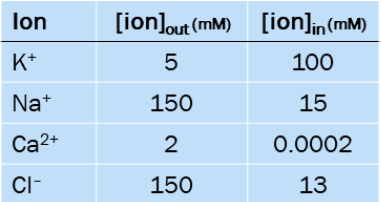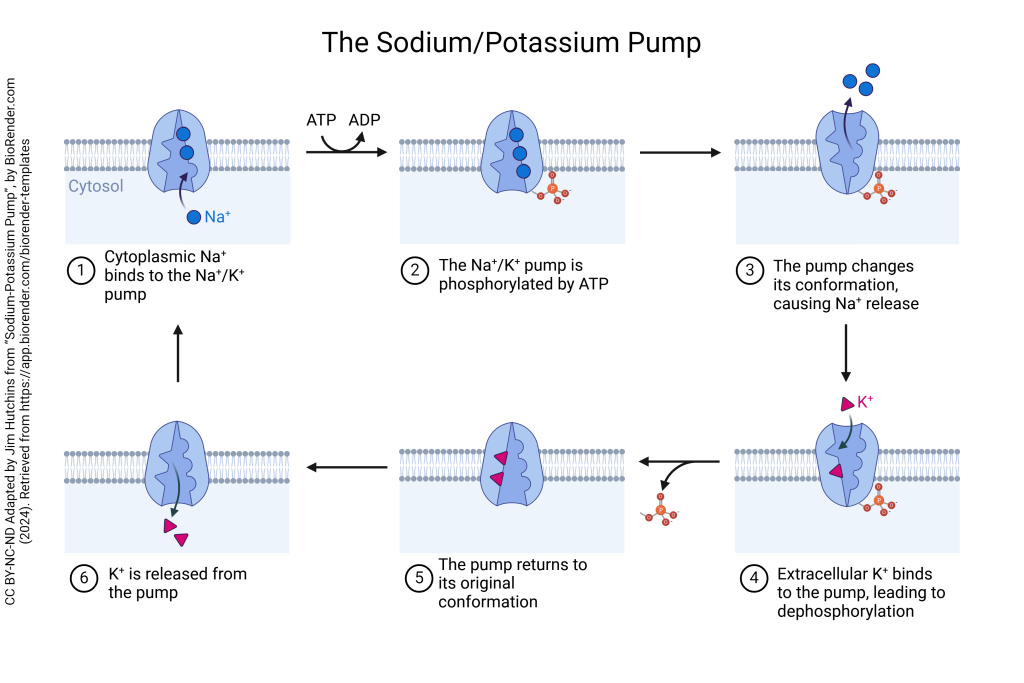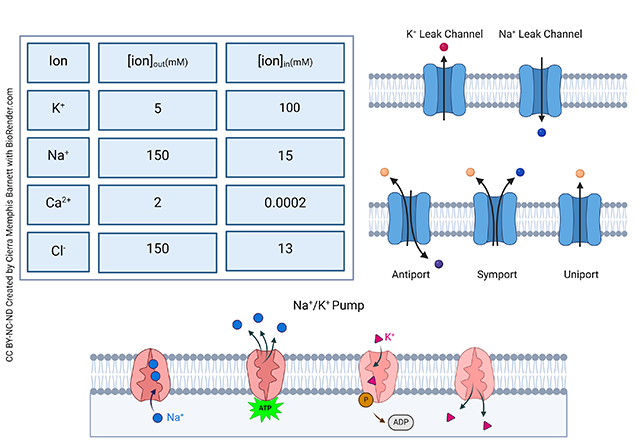The Sodium-Potassium Pump
Objective 2
Explain the action of the sodium-potassium pump (Na+/K+ ATPase).
The concentration of four key ions (K+, Na+, Ca2+, and Cl–) both inside and outside the neuron is shown in the table. It’s not important to learn these numbers: they’re hard to measure, so scientists are not so certain about them, and in any case they probably vary between different cells. What is important is what ions predominate where.

 Scan the outside concentration of ions column. (Remember square brackets mean “the concentration of” so [ion]out is read as “the concentration of an ion outside the cell”.) The two largest numbers are Na+ and Cl– at 150 mM (0.15 M) each. Huh! We’ve talked many times about using 0.9% (150 mM) NaCl as a blood replacement in the clinic, and there it is.
Scan the outside concentration of ions column. (Remember square brackets mean “the concentration of” so [ion]out is read as “the concentration of an ion outside the cell”.) The two largest numbers are Na+ and Cl– at 150 mM (0.15 M) each. Huh! We’ve talked many times about using 0.9% (150 mM) NaCl as a blood replacement in the clinic, and there it is.
Now look at the [ion]in (“concentration of ion inside the cell”) column. The highest concentration, by far, is potassium at 100 mM. [Na+] is about 1/7 that of [K+] and [Cl–] is about 1/8 that of [K+]. The concentration of calcium ions ([Ca2+]) is close to zero, about 10,000 times lower inside than outside. We’ve already seen how Ca2+ is used to regulate cellular processes, and we’ll extend that knowledge in this Unit. To run a Ca2+-dependent process, we need to manage the concentration of free Ca2+ quite tightly by putting it away in a bag (as in skeletal muscle: Unit 10) or holding onto it with a protein. Mitochondria also act as Ca2+ sponges. We’ll see the implications of this miniscule intracellular [Ca2+] in Objective 8: together with voltage-gated Ca2+ channels, it’s responsible for the action of the synapse.
Na+ is high outside, low inside the neuron. K+ is low outside, high inside the neuron. These concentration differences are maintained — but not created — by the Na+/ K+ pump.
Scientists estimate a single protein, the sodium-potassium pump, uses about 1/3 of the total energy consumption in the human body. For the cells of the nervous system, this number is about doubled, to 2/3 of the ATP created by the neuron.

Why are the concentrations of these four key ions different inside and outside the neuron? It’s a combination of:
- the number of leakage channels
- the sodium/potassium pump (primary active transport)
- a variety of symporter and antiporter (secondary active transport) systems

Taken together, the contributions of all these different mechanisms keep the neuron in its ideal state, with the inside of the cell having a high potassium and low sodium and very very low calcium concentration.
Media Attributions
- U13-016 Table of Ion Concentrations © Hutchins, Jim is licensed under a CC BY-SA (Attribution ShareAlike) license
- U13-017 Sodium-Potassium Pump © Hutchins, Jim is licensed under a CC BY-NC-ND (Attribution NonCommercial NoDerivatives) license
- U13-018 Combined Effect of Ion Channels, Pumps, and Transporters 640 px © Barnett, Cierra Memphis is licensed under a CC BY-NC-ND (Attribution NonCommercial NoDerivatives) license

